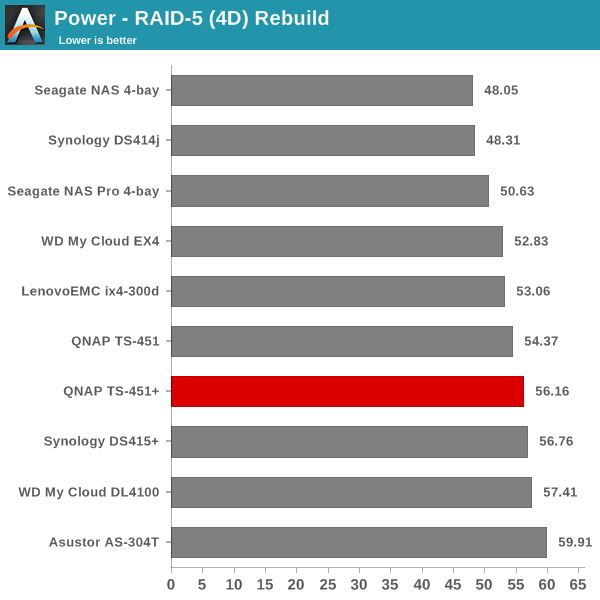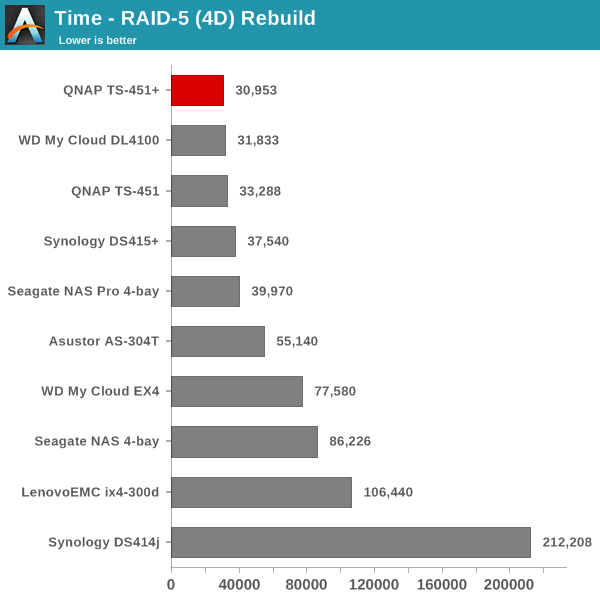QNAP TS-451+ SOHO NAS Review
by Ganesh T S on October 29, 2015 8:00 AM ESTMiscellaneous Aspects and Final Words
In order to keep testing consistent across all 4-bay units, we performed all our expansion / rebuild testing as well as power consumption evaluation with the unit configured in RAID-5. The disks used for benchmarking (Western Digital WD4000FYYZ) were also used in this section. The table below presents the average power consumption of the unit as well as time taken for various RAID-related activities. In the genera state with the hard disk powered on, but not actively reading or writing data, the power consumption was around 50 W, though it dropped to around 16 W with the disks in sleep mode.
| QNAP TS-451+ RAID Expansion and Rebuild / Power Consumption | ||
| Activity | Duration (HH:MM:SS) | Avg. Power (W) |
| Single Disk Init | - | 20.47 W |
| JBOD to RAID-1 Migration | 08:21:12 | 33.33 W |
| RAID-1 (2D) to RAID-5 (3D) Migration | 20:52:59 | 44.11 W |
| RAID-5 (3D) to RAID-5 (4D) Expansion | 22:35:18 | 53.09 W |
| RAID-5 (4D) Rebuild | 08:35:53 | 56.16 W |
The graphs below show the power consumption and rebuild duration when repairing a RAID-5 volume for the various 4-bay NAS units that have been evaluated before.

The TS-451+ takes very little time to rebuild the NAS volume. However, the power consumption is on the higher end of the spectrum. Overall, the efficiency (energy consumerd in the process) should definitely be in QNAP's favor.

Concluding Remarks
The TS-x51+ series is the latest addition to QNAP's lineup targeting the home users / SOHO market. There is a distinct multimedia focus with the bundled IR remote. Braswell would have further strengthened the multimedia credentials, but QNAP has opted to strangely continue with Bay Trail for this product line. Other than that, the performance of the unit is just slightly better than that of the TS-451 that we evaluated last year.
QNAP's firmware, though, has been improving by leaps and bounds with every release. QTS 4.2 has brought in a host of new features. The NAS is pretty flexible and provides a large number of add-ons as well as third party apps. The TS-451+ is also capable of supporting multiple virtual machines, though, with just two network ports, it is unlikely that consumers will want to run more than one. Earlier this year, QNAP launched Container Station, which adds Docker functionality to QTS. Obviously, QNAP's transcoding functionality that takes advantage of Intel's Quick Sync engine is present in the TS-451+ also. Along with the Hybrid Desk app (Chrome / Kodi etc.) and QvPC technology, the NAS can be used just like a PC for most purposes.
The above advantages aside, there are certain areas where QNAP could improve. One of the main points is the quality of the drive bays in the TS-451+. At the target price point, we need metal drive trays. On a more generic note, QNAP needs to move to Braswell soon while also delivering support for the btrfs file system (in addition to the currently supported EXT4).
The TS-x51+ series has four members - the TS-451+-8G-US coming in at $649, the TS-451+-2G-US coming in at $529, the TS-251+-8G-US coming in at $499 and the TS-251+-2G-US at $399. The price point is definitely an issue, as the TS-453 Pro with 8 GB of memory is currently available in Amazon for $645. For a similar amount, users can get two extra LAN port as well as an extra USB 3.0 port, and there is no power brick to deal with. The only downside is that there is no bundled IR remote in the TS-453 Pro. For users who don't need the IR remote control capabilities (i.e, those who are not going to hook up the NAS to a display and run XBMC / Kodi directly on the NAS), the TS-453 Pro is a much better choice in all respects.
In terms of firmware capabilities and performance for this market segment, there is nothing to complain about in the QNAP TS-451+. The NAS with the included IR remote is attractive for multimedia enthusiasts who want to use the unit also as a media player. At the currently available price points, we would recommend the TS-453 Pro over the TS-451+. For the TS-451+ to become a compelling choice, the pricing aspect needs to be addressed.











34 Comments
View All Comments
BedfordTim - Friday, February 19, 2016 - link
If you look at Amazon reviews you will find that there is no customer support for a NAS either. At least with off the shelf parts if your power brick fails you can just buy another one. If your proprietary Netgear power brick fails you are facing hours on a premium rate phone line as they don't respond to web requests.kmmatney - Sunday, November 1, 2015 - link
I never got over the pricing either, and went the WHS route. I started out with a machine built with spare parts 6 years ago, and added hard drives to the system as I went, and now have 9 drives in it. I use Stablebit drivepool for drive pooling and redundancy, which I like better than using RAID. It started out with a Sempron processor which was fine in the beginning, but upgraded to a core i5 Devil's Canyon so I could run several minecraft servers. Too bad they stopped support for WHS. I'll probably just move to Windows 10 in the future.bsd228 - Friday, November 6, 2015 - link
That's a list price. The predecessor (the 451 non plus - essentially the same but with a 2.4ghz dual core instead of this 2ghz quad core) sells in the 300 (great sale) to 450 range. Amazon already lists the 451+ at 529 for the 2gig memory model.If size doesn't matter, and you're up to the task on the software side, then yeah, you can make something better for the same money. Or do it slightly cheaper. And I've done that many times with HP Microservers, and might again with a Fractal Design 304 case. But if it's not your expertise or your time is better spent elsewhere, these turnkey solutions are great. Qnap and Synology have a lot of applets, and now even the ability to run a VM for additional wants.
Oscarcharliezulu - Friday, October 30, 2015 - link
Article mentions raid rebuild is fast but if I'm reading it right rebuilds take 8 hours plus! Why do they (all) take so long? QNAP needs to support btrfs or ZfS so we can have a file system that properly protects against file corruption not just disk failure.Sivar - Friday, October 30, 2015 - link
An important and oft-overlooked issue with most home NAS units (QNAP, Drobo, Synology) is that if your unit dies out of warranty, that's it -- these companies offer no repair option or support.This is a problem with Drobo especially because they use a proprietary file system. You can of course buy another unit, if available, and move the drives over, or buy a newer model and hope for turnkey compatibility.
With a custom home NAS, well within the capabilities (if not spare time) of most Anandtech readers, you can upgrade and repair parts easily.
DanNeely - Friday, October 30, 2015 - link
Linux based NASes - like almost everything but the Drobo - use standard Filesystems, and can be recovered by sticking the drives in a normal Linux box.BedfordTim - Friday, February 19, 2016 - link
It isn't much better if they die in warranty. All NAS makers have dire reviews for customer support. Netgear has a premium number for support and a healthy queue length (30-60 minutes this morning) to maximise revenue.Navvie - Monday, November 2, 2015 - link
What would be nice is a comparison with a roll-your-own NAS solution. For example, a HP Microserver G2020T running FreeNAS or nas4free.colonelclaw - Tuesday, November 3, 2015 - link
We've been running a QNAP box that's extremely similar to this one in our office for the last couple of years, and I have to say we're extremely happy with it. We use it as an online archive of completed projects that have already been backed up, so it doesn't get a huge amount of use, but it probably shunts a terabyte or two around every week.My one criticism is that it feels like every time I log onto the admin console via a web browser it asks to install a new firmware update, but I can put up with this (mainly by not needing to log in that often).
akdubya - Wednesday, November 4, 2015 - link
"For the TS-451+ to become a compelling choice, the pricing aspect needs to be addressed."You aren't kidding. I recently put together a comparable Braswell (N3700) system for under $250. And the Braswell SoC's feature AES NI, 4K and HEVC. Yikes! Between the anemic warranties and the severely underpowered and/or overpriced hardware I'm just not seeing the value in these proprietary SOHO NAS boxes. Is it really so hard to jam PLEX/Kodi/Samba on an Ubuntu server these days? And no need to jump through hoops to "use it like a PC" because it is a PC.